The Video Marketing Guide: All you need to know
Contents
So you’ve heard.Video content has become the consumer’s favourite source of information.In a 2019 report by CISCO, it’s stated that video will account for 82% of all internet traffic by 2022.Brands all over the world have been reacting to this trend, incorporating video into their marketing strategies to reach out to more potential clients.In such a competitive market, your brand cannot afford to be left behind.That’s precisely why we at Studiotale have created this ultimate guide on video marketing - to give you our video marketing experience and insights so that you can get a piece of the action.By the end of this article, you’ll be all set to plan, implement and evaluate a video marketing strategy that will take your brand to the top of the ladder.Sounds good?Well then, get a notepad out - it’s time to get started.
Content
[/vc_column_text][/vc_column][/vc_row][vc_row full_width="stretch_row_content" css=".vc_custom_1568125007567{padding-right: 5% !important;padding-left: 5% !important;}"][vc_column width="1/4"][vc_single_image image="26799" alignment="center" style="vc_box_circle_2" onclick="custom_link" link="#1"][vc_column_text]
Chapter 1
What is Video Marketing?
[/vc_column_text][/vc_column][vc_column width="1/4"][vc_single_image image="26800" alignment="center" style="vc_box_circle_2" onclick="custom_link" link="#2"][vc_column_text]
Chapter 2
Video Marketing Importance
[/vc_column_text][/vc_column][vc_column width="1/4"][vc_single_image image="26801" alignment="center" style="vc_box_circle_2" onclick="custom_link" link="#3"][vc_column_text]
Chapter 3
Types of Videos
[/vc_column_text][/vc_column][vc_column width="1/4"][vc_single_image image="26802" alignment="center" style="vc_box_circle_2" onclick="custom_link" link="#4"][vc_column_text]
Chapter 4
Video Marketing Strategy
[/vc_column_text][/vc_column][/vc_row][vc_row full_width="stretch_row_content"][vc_column width="1/4"][vc_single_image image="26805" alignment="center" style="vc_box_circle_2" onclick="custom_link" link="#5"][vc_column_text]
Chapter 5
Sales Funnel
[/vc_column_text][/vc_column][vc_column width="1/4"][vc_single_image image="26806" alignment="center" style="vc_box_circle_2" onclick="custom_link" link="#6"][vc_column_text]
Chapter 6
Making the video
[/vc_column_text][/vc_column][vc_column width="1/4"][vc_single_image image="26808" alignment="center" style="vc_box_circle_2" onclick="custom_link" link="#7"][vc_column_text]
Chapter 7
Tools
[/vc_column_text][/vc_column][vc_column width="1/4"][vc_single_image image="26807" alignment="center" style="vc_box_circle_2" onclick="custom_link" link="#8"][vc_column_text]
Chapter 8
Optimising for SEO
[/vc_column_text][/vc_column][/vc_row][vc_row full_width="stretch_row_content" css=".vc_custom_1568125029782{padding-right: 5% !important;padding-left: 5% !important;}"][vc_column width="1/2"][vc_single_image image="26817" alignment="center" style="vc_box_circle_2" onclick="custom_link" link="#9"][vc_column_text]
Chapter 9
Social Media Video Marketing
[/vc_column_text][/vc_column][vc_column width="1/2"][vc_single_image image="26809" alignment="center" style="vc_box_circle_2" onclick="custom_link" link="#10"][vc_column_text]
Chapter 10
Performance Analysis
[/vc_column_text][/vc_column][/vc_row][vc_row full_width="stretch_row_content_no_spaces" css=".vc_custom_1568107327472{padding-top: -50px !important;padding-bottom: -50px !important;}" el_id="1"][vc_column][vc_single_image image="26799" img_size="full" alignment="center"][/vc_column][/vc_row][vc_row][vc_column][vc_column_text]

What is Video Marketing?
Video marketing is a form of content marketing that uses video content to promote your brand, product or message across to the target audience.
The aim of video marketing is to make it easier for the viewer to understand your message.
How does it do this?
Glad you asked:
Why Video Marketing is so effective
Video content is like the John Wick of content types.
It ‘takes care’ of a lot of targets at once, making the phrase “two birds with one stone” look like child’s play.
So what exactly can video content do for your business?
1. Congrats on the engagement
There’s a lot of content out there.
Your job is to make sure your content can navigate around this storm of information and reach the right people.
And to do that, you need to be able to hold their attention from start to finish.
That’s exactly what makes video content so powerful.
Video lets you take pages and pages of boring old text and convert it into something so much more exciting.
And it isn’t just repurposed content.
No matter what your message is, video can easily convert it into something more visual and easier to understand.
Through stunning visuals and engrossing audio, you can create a truly amazing video that your viewers can’t take their eyes off - all while explaining your idea to them!
2. They will remember you
It’s not enough for you to just grab the audiences’ attention with your content.
Your message needs to be remembered to be truly effective.
This is called consumer retention, and it’s a major part of the buyer’s journey to actually purchasing your product (We’ll get to that later).
Video trumps other forms of content yet again, with 80% of consumers recalling a video ad that they viewed in the past month.
3. Conversion. So much conversion!
The high engagement and retention rates that videos can achieve naturally means that video boosts conversion rates.
In fact, 81% of marketers say that video content helped them convert prospective customers into leads.
Now that’s a figure you simply can’t ignore in the world of marketing.
4. Video is the Big Daddy of SEO
SEO or Search Engine Optimization is the holy grail of digital marketing.
You’re not going to be engaging anyone with your content if it gets lost in the sea of information online.
SEO tells Google and other search engines that your content is exactly what the audience is looking for.
And boy does Google love video.
There’s a reason 84% marketers say video content helped them increase traffic to their website.
We’ll talk about Video SEO in more detail a little later.
5. Returns that are too good to be true
With conversion rates that are so high, it isn’t surprising that video boasts amazing Returns on Investment.
With the same video, you can generate thousands of leads!
According to 83% of marketers, video produces an amazing ROI.
So if you’re looking to get the max out of your marketing ad budget, you know exactly what to do.
6. Mobile users can’t get enough video
There are a plethora of devices connected to the internet today.
This means that by not optimising your video for different devices, you’re missing out on a HUGE opportunity.
In fact, only 1% of consumers say they watch all their video content on a desktop.
This means the other 99% have access to other kinds of screens that play video content.
That’s a HUGE number to not be targeting!
Expand your reach by optimising your videos for mobile phones, tablets and other devices and watch your view count multiply!
7. Videos bring emotion into the picture
This one’s a no brainer.
Facial expressions, voiceovers, music, colour schemes - all make video content the undisputed King of conveying an emotion online.
By associating an emotion or a feeling with your message, you make your brand feel more human and relatable.
How does this help?
Your audience will begin to trust you because they can relate to your video!
[powerkit_posts title="" count="1" offset="0" image_size="pk-thumbnail" category="" tag="" ids="19694" orderby="date" order="DESC" time_frame="" template="list"]
8. Sharing is caring
Imagine if thousands of your prospective customers promoted your content for you.
It may sound like something out of a John Lennon song, but video can do just that for you.
With almost 50% of consumers saying they’d share video content on social media, videos encourage more social shares than any other content type!
Meaning by simply getting your video to the right people, you’re going to see massive engagement rates - without lifting a finger.
9. Video improves email CTR
I think we all agree how important newsletters and emails are for a business that’s trying to reach out to more people.
But has your business been seeing dismal email open rates and mediocre CTRs?
Here’s something you definitely need to try out:
Add video content to your email.
Studies show that using video in an email increases Open Rates by 19% and Click Through Rates by about 50%!
By simply including the word ‘Video’ in the subject line, your email open rate boosts up by about 20%!
If you want to know more about how to increase email open rates with video, head over to our article on Using Videos in Emails.
10. Videos have better trackability
This is another amazing thing about video content.
Blogs and other content types will only tell you how many people viewed the page.
There is literally no other way to measure how much of your message the audience has heard.
Videos take it up a notch.
Video analysis doesn’t just show you how many people viewed your video - With the right tools, you can also see how many people made it to the end of the video, where viewers were exiting the video and the exact point in the video where the most number of people stopped watching.
What can you do with this info?
You can figure out what content caused audiences to leave, what duration audiences stay for the most etc
This allows you to make the right changes to your next video and keep more viewers interested from start to finish.

Video Marketing in 2019
Video marketing has become more important than ever in 2019.
Just look at these stats based on a survey conducted by Wyzowl:
87% of consumers want to see more video content from brands in 2019.
91% of marketers say video has been an important part of their marketing strategy.
And even though 90% of marketers feel the competition has increased in the past year, 99% of them will continue using video in 2019.
Video is clearly KILLING it in terms of content marketing.
If you haven’t begun using video content in your marketing strategy, you’re seriously lagging behind the competition.
You need to get started on your video content ASAP!
Still need more convincing? Here are some powerful statistics that show you the state of video marketing in 2019 and the direction in which it's going in:
- Over 2 billion logged-in users visit YouTube every month. That’s 1/3rd of the total internet traffic. (YouTube)
- 68% of people say they would rather find out about a new product, service or brand by watching a short video rather than having to read about it. (Wyzowl)
- Social Media posts with video get 48% more views (Hubspot)
- The average user spends 88% more time on websites with video. (Forbes)
- Marketers who use video grow revenue 49% faster than those who don’t. (Wordstream)
- Video drives a 157% increase in organic traffic from SERPs. (Brightcove)
- 32% of consumers check out a brand’s presence on social media before visiting their website. (Animoto)
- 54% of social browsers research products on social media. (GlobalWebIndex)
- 74% of consumers say they visit Facebook daily. (SproutSocial)
- Video is the best performing content type on Facebook. (SocialMediaToday)
- Instagram Video posts get 2x the engagement of Image posts. (Animoto)
- The year 2017 saw an 80% increase in the number of users watching video on Instagram. (Instagram)
- LinkedIn is the second most preferred channel among executives for sharing business-related content. The first is email. (NeilPatel)
- LinkedIn users are 20 times more likely to share video over all other forms of content. (SocialMediaToday)
- Video is Twitter’s fastest-growing advertising option. (Twitter)
- Twitter content with videos have 10x better engagement than those without. (Twitter)
- Only 1% of consumers say they watch all their video content from a desktop. The remaining 99% also watch videos on smartphones and tablets. (Wyzowl)
- Over half of the total video traffic comes from mobile phones. (Wordstream)
- 74% of marketers who’ve used 360-degree video say it’s been successful for them. (Wyzowl)
- Interactive videos see 66% better engagement rates than ordinary video. (Brightcove)
- The most online videos are watched by Millennials (25-34 age group). (Wordstream)
- The first 2.7 seconds of a video is where the viewer pays the most attention. A brilliant start will reduce the number of ad skippers. (MarketingMag)

Types of videos used by businesses
There are several types of videos your business could use to build awareness and engage target audiences.
Let’s dive right into them.
1. Explainer video
Explainer videos are small, bite-sized videos (usually a minute long) that simplify your product, service or idea to your audience.
They usually cover four key points- the problem, the solution, the features and benefits, and a call-to-action.
You can use explainer videos on your home page or product page, at sales demos, events and in newsletters.
They can be used by all kinds of businesses- startups, B2B and B2C businesses and work great at the top of the funnel.
Explainer videos can be broadly categorized into two types:
a. Animated Explainer videos
Check out this video created by Studiotale for Atoka. This 90-second explainer video highlights that Atoka is a search platform that presents information about Italian and British companies. The main aim is to help people in search of local businesses.
b. Live-Action explainer video
Check out this amazing example by DollarShave Club. This video stands out for its humor and wit. The founder talks about the blades they make and highlights why you should buy them uniquely and humorously.
On average, it takes about 5-8 weeks to create an explainer video and it can cost from $5000 to $50000.
If you want to better understand how explainer videos work, be sure to check out our Definitive Guide.
Need an explainer video? Don’t hesitate to contact us at Studiotale and we’ll see what we can do.
2. Commercial videos
Commercial videos are engaging teasers ideally around 30 seconds long, used by companies to promote their product or service.
They grab attention and create a buzz around what you do. Promotional videos seldom go into the details of what a company does and how they do what they do.
This kind of video is perfect for spreading awareness and excitement about a product or service and usually require a high budget.
Commercial videos can be used in video ad campaigns on YouTube and social media platforms like Facebook, LinkedIn, Twitter and Instagram.
On average, it takes around 5-7 weeks to create a commercial video and can cost from $10000 to $50000.
Check out this video by Apple that was created to launch the iPhone XR. The video uses catchy background music, attractive images and animation to highlight the product’s unique features.
3. Product demo videos
Product demo videos provide step-by-step instructions on how to use the product. They’re usually used to educate new customers and inform existing users about an update.
You could use them to respond to emails and even put them up on the FAQ page.
These videos are also used by B2B, B2C and SaaS to show viewers how the product works so that they can see for themselves why their product is better than the competition.
On average, it takes around 4-6 weeks to produce a product demo video and can cost from $3000 to $15000.
Check out this demo video by Slack, a messaging application for the workspace. The video discusses the features of the platform in detail using an engaging script, beautiful transitions, and pleasant background music.
4. Company story videos
How do you humanize your business and connect with your audience?
Easy.
Company story videos.
These videos tell your audience the story of your business, its mission, and values.
They usually feature employees talking about the work they do or founders explaining the vision that started the company and its journey so far.
They’re a great way to attract fresh talent to your business and work perfectly on ‘About Us’ or ‘Meet the team’ pages.
On average, they take around 5-7 weeks to create and usually carry a price tag from $5000 to $30000.
One of the best examples of this video type is by HubSpot. The video has the founders of the company talking about why they created HubSpot, how they created the company, their mission and their journey so far. They also talk about the underlying idea of inbound marketing and why their customers love it.
5. Company culture videos
Company culture videos showcase your brand’s personality, both at the individual level and as a company to the consumers.
These informal videos a great way to add a human touch and connect with your audience on a more personal level.
Zendesk created this video to show off the work culture at their office in Dublin. The video stands out for its light humor and casual mood. Without any narration, it shows the chemistry between employees engaged in different activities at the workplace and effortlessly gets its point across.
6. Live videos
Want to interact with your customers in real time?
Use live videos!
Live videos work great because it attracts audiences on social media by giving them the chance to get the brand’s latest news and updates in real time.
They let you interact with your audience directly, encouraging viewer participation and enhancing customer experience.
You could use live videos to cover an event, host a Q&A session, announce a new product or conduct an interview.
Live videos are also cost-effective because you can create them using just your smartphone or webcam.
Check out this Facebook live video by Starbucks. Starbucks filmed their celebration of the National Voter Registration Day. The video captures Starbucks baristas as they explain to the public how important it is to exercise the right to vote and lead by example, registering to vote themselves. The live video garnered an amazing 175K views.
7. Testimonial video
Testimonial videos are the best way to build trust among potential customers.
In this kind of video, one or more of your clients talk about how they’ve been using your product or service and how it made their lives easier.
These videos go a long way in strengthening your brand image and building trust among consumers.
The most important thing to keep in mind while making a testimonial video is to keep things honest. Your audience will only if the testimonial is genuine.
They help strengthen your brand image and are great content for the bottom of the funnel. You can use these videos on your home page or a separate customer page.
On average, a testimonial video takes around 3-5 weeks to create and can cost from $5000 to $15000.
In this Uberflip testimonial video, Lisa Kenney talks about how she uses Uberflip to generate leads, measure ROI and create content hubs at Blackbaud, a software company.
8. Retention video
Retention videos are a great way to connect with the customer after they have purchased your product. These could be thank you videos, festival greetings, videos meant to answer a specific query or to discuss a product update.
A retention video is a great way to ensure your customer stays interested in your brand.
You can use these videos in email newsletters or on your social media channels.
On average, it takes around 3-6 weeks to create and can cost from $3000 to $10000.
Check out this example BMW created to wish their audience A Merry Christmas. The concept is unique and the video perfectly connects with the viewer.
Alright.
You now have an understanding of the different kinds of video content that businesses use to connect with their audiences.
It’s time to draw up a video marketing strategy yourself.

Creating A Video Marketing Strategy
Before we begin this chapter, major disclaimer here - There is no such thing as a foolproof video marketing strategy that guarantees success.
Most strategies are created through trial and error and tweaked to perfection.
However, to get started on a basic strategy, we’ve highlighted some key points to keep in mind:
1. Set your campaign goal
Duh.
You can’t begin planning a video marketing campaign, if you don’t know what you want it to do in the first place.
Is your goal to increase brand awareness or is it to market a particular product?
Are you trying to increase traffic to your website?
Or are you trying to increase audience engagement?
Who is your target audience and what do they want to see in a video?
Understanding your goal is the first step to creating a marketing strategy that’s result oriented.
2. Understanding the video that fits your goals
The next step is to figure out what kind of video will best help you achieve the goals you’ve set.
Do you need an explainer video or a company culture video?
To figure that out, you’ll need an understanding of the sales funnel and how videos fit into it.
We’ll talk about this in the next chapter.
3. Be consistent with your message
Throughout your video marketing strategy, you’ll need to be consistent.
By maintaining a consistent tone throughout your campaign, you make it easier for your audience connect your message to your brand.
That’s exactly what your consumers want!
That’s why 87% of consumers want to see more branded videos from businesses.
4.Set the right budget
Just like any other marketing strategy, you need to figure out how much of your budget to allocate to your video marketing efforts.
This mainly depends on the kind of video you want.
You could create your video in-house and save up on your budget.
But if you’re looking for a little more quality, you’re going to have to lighten your wallet a little and hire a video production agency.
5. Optimise your video
This is really important in the world of video marketing.
With the number of internet ready devices today, it’s vital that you optimise your video for multiple platforms to create the biggest impact you can.
And with 93% of all online experiences starting with a search engine, you’ll need to make your video content more visible to the consumers to be able to successfully promote your message.
That’s where Video Search Engine Optimization (or Video SEO) comes in.
If you want to understand how to use SEO to increase your video’s reach, be sure to check out our blog - “Nailing Video SEO Like A Pro”.
Again, these 4 points are only going to help you create a basic skeletal structure for your video marketing strategy.
It’s up to you to polish this structure through trial and error and tweak it until you have a strategy that works for you.
It’s time to take a look at what marketers call the sales funnel and understand what kind of video fits for your requirement.

The Sales Funnel - How Videos Fit In
A sales funnel is a map of the journey that a potential customer goes through as they decide to buy your product.
It begins with the target audience first being aware of your solution and ends with your newfound customer purchasing your product.
The stages of a sales funnel are:
- Awareness
- Consideration
- Decision
- Action

Let’s quickly understand each stage and check out the videos that fit the bill.
1. Awareness stage
This is where your prospective customer first becomes aware of your existence.
You need to introduce your product or brand as a possible solution to the problems they’re facing.
Videos that work best in this stage : SEO driven videos, Commercial videos, Homepage Videos
2. Consideration stage
Your prospective customer is now aware that you exist. Now they’re conducting their own research to figure out whether or not to trust your solution. You need to reassure them of your product’s benefits to get them to pick you from the competition.
Videos that work best in this stage : Demo videos, Webinars, Case Study Videos
3. Decision stage
The prospect has decided that you are indeed the best choice among the competition. You now need to guide them into taking the leap and buying the product. The best way to do this is to bring in a human touch so that the prospect can trust you more easily.
Videos that work best in this stage : Testimonial videos, Company Story Videos
4. Action stage
Your prospect is now a customer. They have purchased your product and have begun using it. But your job isn’t over yet!
Customer satisfaction is key to any good business strategy.
This is where you ensure that your new customers have a good experience with your product.
Videos that are meant for this stage : Onboarding videos, Retention videos.
If you’re looking to get a more in-depth understanding of How To Use Videos In A Sales Funnel, be sure to check out our article now!
Alright.
You’re all caught up with sales funnels and how videos enhance them.
It’s time to move on to the most important part of your video marketing strategy:

Making The Perfect Video
It doesn’t matter how solid your video marketing strategy is - a lacklustre video is going to ruin any chances you have of connecting with your audience.
One way to solve this problem is by hiring a video production agency to do it for you.
But if you’re looking to do things yourself, here are some things you need to keep in mind:
Live Action or Animated?
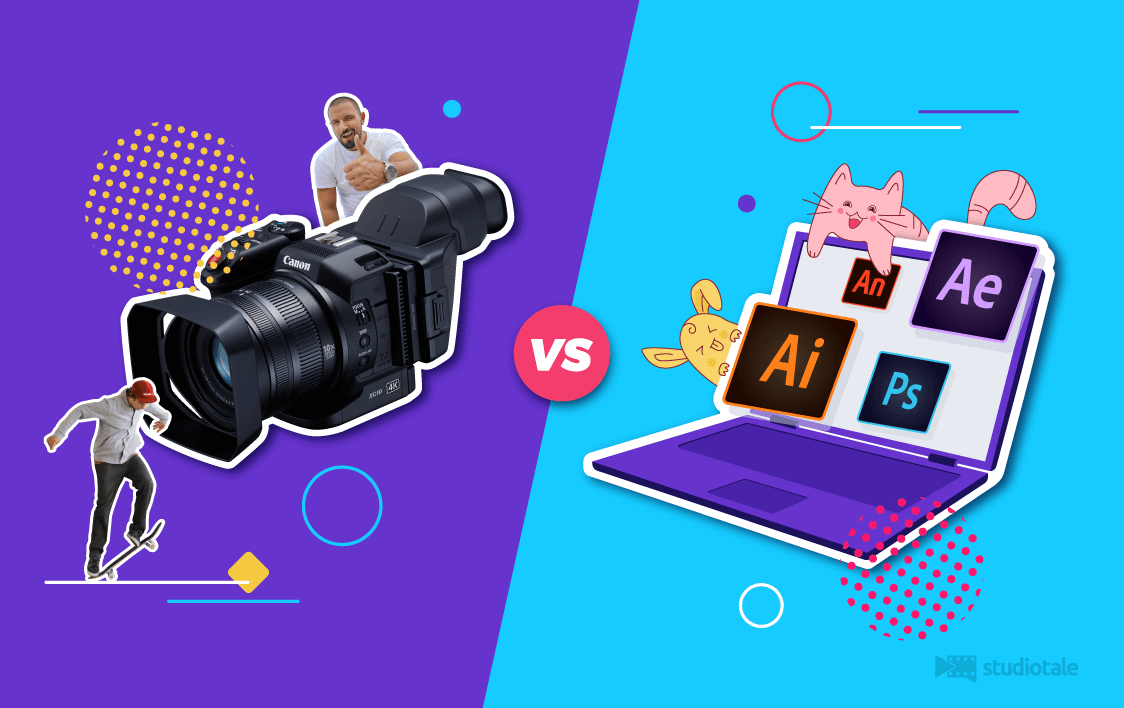
This is the very decision you’ll need to make.
Depending on the message you’re trying to get across, you’ll need to decide if you want to create a live action video or an animated one.
- Live Action Production
Pros
- Human Factor
- Your Product Is The Highlight
- Lesser Time To Produce
- Best For Serious Messages
Cons
- Can Get Costlier
- Nightmare Revision Times
- More Creative Constrictions
- Animated Production
Pros
- Endless Space For Creativity
- Revisions Are Easy
- Visualise Abstract Ideas
- Cost Friendly
Cons
- Longer Production Time
- Lack of Human Element
If you’ve decided to create an animated video, do check out our 7-step guide to the animation process.
To get a better idea of the pros and cons of each video style, check out our article - Animation vs Live Action Videos : How They Work For Businesses.
1. Center it around a concept
All engaging videos have one thing in common - They’re centered around an idea, a concept that holds the narrative together.
And this is why the ideation phase is so important.
You’ll need to create a central theme that compliments the message of your video.
At Studiotale, we begin by sending our client a creative brief for them to fill, which you can download below:
In short, the creative brief is a questionnaire to help our client explain their requirements better. It covers details like the video’s purpose, target audience, and their quick elevator pitch.
Using a creative brief, you get a better idea of your requirements - allowing you to build a strong, engaging concept and use it as the foundation for the rest of the video.
2. Tell a story
People have always been fascinated by stories - It’s no secret.
So why not use a story to get your idea across?
Using a storyline brings a new level of engagement to the video.
With a flowing narrative, you could draw your audiences deeper into your video and get the concept across more effectively.
If you want to improve the impact of your scripts, I suggest checking out our blog on Effective Script Writing.
3. Be relatable
Relatability is key if you want to connect with your audience.
Put yourself in the shoes of your target audience.
Find out their likes and dislikes.
Understand the situations they find themselves in and draw a parallel narrative from it.
With relatable narratives, characters or themes, you will connect to the viewer on a more personal level.
4. Build an atmosphere
The most important part of making your video engaging is the atmosphere you create.
With stunning visuals and resonant audio, you can create a truly immersive experience with your video.
Draw your viewer into the world that you’ve created with eye catching colour schemes and memorable characters.
Find the right voiceover and be consistent with the tone throughout the video and you’ll see engagement levels go up immediately!
Keeping these tips in mind, you will soon be creating videos that successfully engage audiences and drive conversions.
Now that we’ve got that out of the way, it’s time to give you the tools for the actual video production.

Every Video Production Tool You’ll Need
Most of these tools are free, to begin with.
Some tools like Kapwing will give you all their resources for free in return for a simple blog post 😉.
But I suggest that you get yourself a subscription anyway. They’re not exactly expensive to begin with.
Plus the added features in the full versions of each tool are going to be useful later.
Go through these lists and pick the tools that suit you best.
Let’s start with the first list:
Online video creation and editing tools
- Rawshorts
- Animaker
- Powtoon
- Wideo
- Vyond
- Viddyoze
- Biteable
- Renderforest
- Animoto
- Moovly
- Wave.video
- VideoScribe
- Loom
- GoVideo by Vidyard
- Soapbox by Wistia
- Hippo Video
- Kapwing
- Adobe Spark
Free stock footage resources
Stock footage can be a lifesaver when it comes to video production that’s either on a low budget or happening under time constraints.
These platforms offer up free stock footage that you can use in your video marketing efforts.
For free stock photography:
For free stock footage and audio:
Audio resources
If you’re looking to enhance the audio of your brand’s video production on a budget, I have some good news.
Check out this list of extensive audio resources to find that perfect groove for your video!
1. Melody Loops
Search by styles, genres, moods and instruments – Melody Loops is a busy marketplace that offers high-quality royalty-free music and soundtracks for all your video marketing needs.
They have music packs that start at $29 for 3 melodies with unlimited downloads.
2. Audiojungle
Have something specific in mind? Have a dollar to spare?
Well search for the perfect track that suits your video marketing strategy by category, keyword or even top artists with Audiojungle.
This database allows you to buy and sell royalty-free music and sound effects starting at $1.
3. Pond5
Pond5 is another online database that offers royalty-free stock and production music tracks. It has a track for every mood and theme – calm, inspiration, dramatic, you name it!
4. SoundCloud
You’ve probably been using SoundCloud to listen to you favourite mumble rapper.
It’s extensive library of free tracks under the “Creative Commons” license is perfect for usage in your video marketing efforts.
But remember – you can use these tracks as long as you follow the guidelines established by the artist.
Turn on the “To use commercially” filter and look for tracks under a Creative Commons license.
Still, I suggest that you reach out to the artist and make sure they’re okay with you using their track in your brand’s video productions.
5. Artlist
The Artlist platform offers high-quality music licensing for any kind of video content.
For $16.60 a month,you get access to their whole catalogue of music, covering all genres and moods.
This also gives you unlimited downloads plus lifetime use, which in my opinion is a pretty sweet deal.
6. Epidemic Sound
Infect your viewers with Epidemic Sound.
This brilliant platform will give you high-quality, royalty free background music for your brand’s next video marketing campaign.
It’s pretty simple to use and has a really big library with a lot of tracks.
Oh and here’s something cool – Epidemic has a ‘find similar’ feature, so you can narrow down what you’re looking for and discover the perfect track for your video production!
The “Creator” subscription is priced at $15 per month, giving you access to 30,000+ tracks and 60,000+ sound effects.
7. YouTube audio library
YouTube’s Audio Library gives you access to a crazy selection of free, royalty-free songs under the ‘Creative Commons’ license.
Filter tracks by genre, instrument, duration, attribution or mood – you’ll have to try really hard to not find the perfect background music for your next video marketing effort.
Voiceover resources
Wouldn’t it be great if Morgan Freeman did a voiceover for your video?
No, I’m not going to tell you how to get Morgan Freeman for your voiceover.
Instead, I’m giving you a list of platforms to find the perfect voiceover artist for your video.
Give your content a voice and grab your audience by the ears.
Great Voiceover Artist Marketplaces:
Captioning and subtitle tools
Captions and subtitles don’t just make your video easier to understand, they also help boost your video’s SEO.
Subtitles and captions help search engines ‘read’ your videos.
With the right keywords in your subtitles, you’ll boost your video’s Google ranking – by a lot!
1. Kapwing
Kapwing is a video and image editor, but it’s also a great subtitle maker for your video marketing team to use.
Upload your video, type in your subtitles and time them right using the Kapwing editor and you’re all set.
2. Rev
Rev is a startup that offers many services that can help you enhance your video content on a budget.
You get transcription and captioning services at $1 per minute each. It also offers foreign subtitling at a price between $3-7 per minute.
3. Temi
Temi is an advanced speech recognition software for speech to text transcription.
It’s great for a small budget, priced at just $.10 per audio minute.
Temi’s free transcription editor lets you edit your transcript online faster than you can snap your fingers.
Ok, maybe not that fast, but it’s still a pretty quick process that’ll let you concentrate on other aspects of your video marketing.
4. Voxtab
Voxtab is another tool that offers transcription, closed captioning and subtitling services.
Voxtab gives you accurate services in over 16 languages. Prices start at $1.25 per minute for transcription and $2 per minute for captioning.
You’ve been armed with the tools, it’s time to get your video out to the audience.
Let’s talk about putting your video online.
Hosting platforms
You could put up your video on YouTube, but the ads will distort your viewer’s experience.
Here are some ad-free hosting platforms that you can use for your video marketing purposes.
Note that these hosting platforms won’t give you unlimited access for free. But, you will be able to put up 5-7 videos per month with an unpaid account, which in my opinion is more than enough.
I’m assuming that by now you’ve decided which video hosting platform to upload your video onto.
However, you still need to make sure these videos are easily found by your target audience.
This is where Search Engine Optimisation comes in.
We’ve spoken about Video SEO briefly in Chapter 1.
It’s time to delve a little deeper into the topic.

A Crash Course In Video SEO
Video SEO works differently from your usual SEO.
Here, you need to compete with videos hosted on different platforms and prove to search engines that your video has the exact content that the audience is looking for.
We’ve got a complete article on Nailing Video SEO Like A Pro on our blog, written by Tim Ferguson of RightMixMarketing.
Here’s 6 of Tim’s 11 Video SEO tips from the article:
1. Choose the right platform
Think video marketing and most people just picture YouTube, and rightly so. There are, however, other avenues.
If your goal through the video is to promote brand awareness and ensure that maximum people view, like and share your video, then platforms like YouTube or Vimeo are your master key. In that case, you need to optimize your video for YouTube.
If however, your goal is to bring traffic to your website using video, note that very few people on YouTube click on an in-video link to visit websites. Most people simply move on to suggested videos.
In this scenario, hosting platforms like Wistia, Vidyard or Hippo Video work great.
2. Video length
Another important factor search engines use to determine an online video’s ranking is the length of the video. Unless your video is an educational or informational piece, try to keep your videos as short as possible.
This will mean more people will get to the end of your video, signaling to search engines that the content is engaging.
3. Title and Description
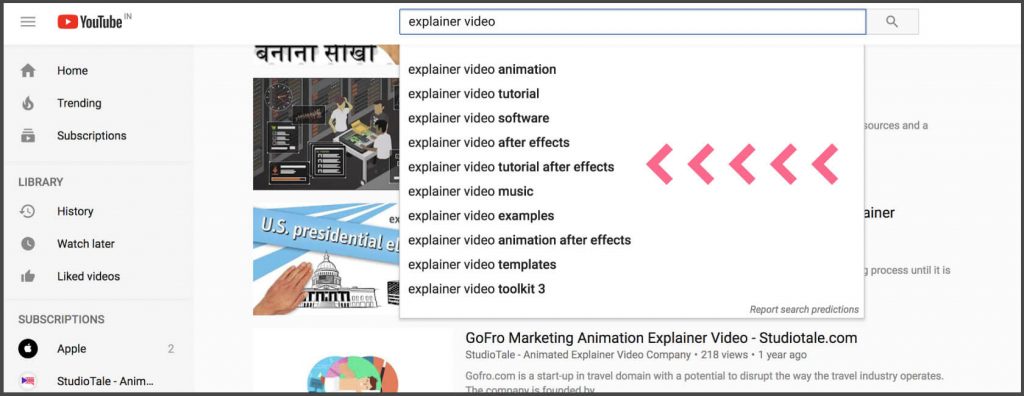
Of course, there’s the title and the description, which are probably the first thing you’ll begin optimizing. So be sure to optimize them, not only by including keywords in it but also by making them sound exciting and promising.
The title should suggest the solution the video is about to offer. The description too must assure the viewers that your video covers everything they are looking for.
Don’t skip the keyword research to make sure you target the most searched phrases. Leverage the handy YouTube suggestions to get a better idea of what your target audience might be searching for. Make it interesting and compelling.
4. Metadata
If digital marketing for onsite traffic is your priority, you need more than YouTube.
You need to rank in organic search results.
Got an explainer video for your expert investing solution? Make sure it ranks whenever someone Googles ‘How to invest’!
There are a few ways to do this.
You can insert SEO metadata in the video to increase your chances of being indexed. JavaScript Object Notation for Linked Data (JSON-LD) is one way to do this.
It helps organize, structure and annotate data using the schema.org vocabulary.
Alternatively, you could use schema markup or create a video sitemap that you can submit to Google Webmaster Tools to help your video rank.
5. High-quality custom thumbnails
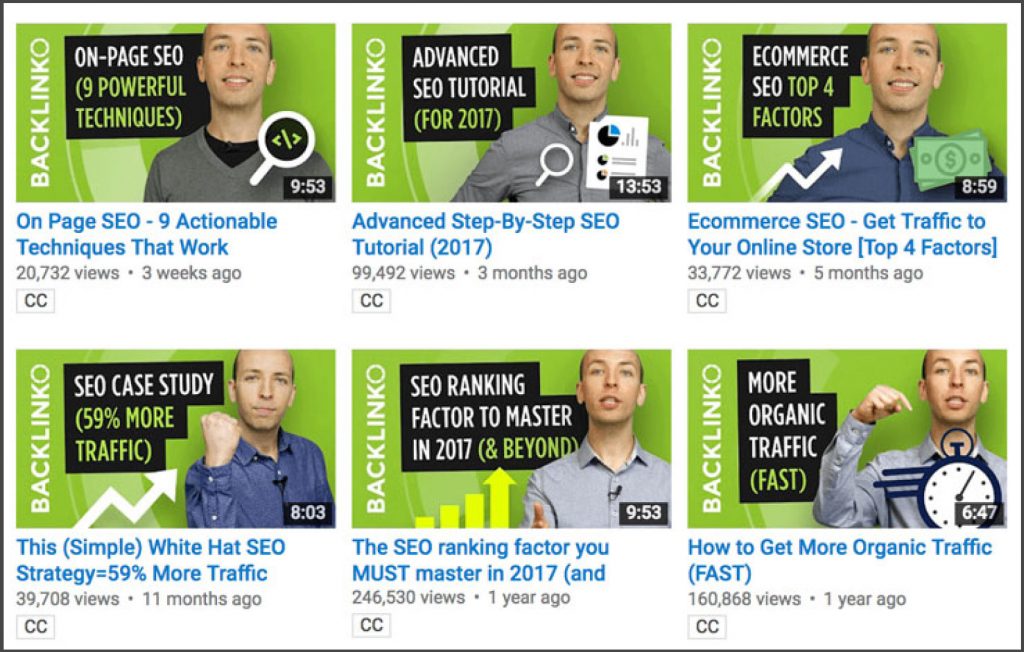
Your thumbnail doesn’t have to be a lackluster, dimly lit screenshot from the video itself. It is the thumbnail that entices viewers to choose your video over the others in the list.
Invest in creating a custom thumbnail for your videos, one that’s compelling and beautiful. Consider taking a custom photograph or creating a graphic for it.
Keep the thumbnail contextual, so it gives an idea of what the video holds. Using text in the thumbnail too can be a great boost for your clickability as well as Video SEO.
6. Transcripts
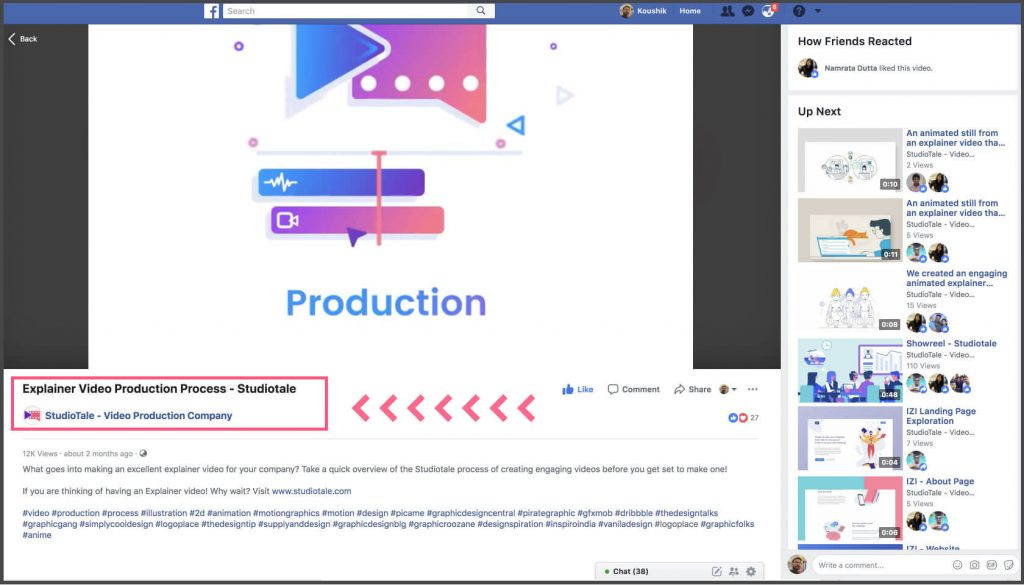
The video name and description offer you only so much space for optimizing for keywords. Submitting a video transcript not only helps you include more keywords to improve your chances of ranking but also make it easier for the bots to crawl your content and rank those keywords.
These transcripts help Google index your video and bring traffic to your page. On YouTube too, adding a transcript in the description can help get your video ranked higher for relevant search results.
These were just 6 of Tom’s Video SEO insights.
Be sure to check out the rest of them in his article “Nailing Video SEO Like A Pro”.
It’s time to get your final video out to the audience.
And with 3.2 billion social media users online today, the social network’s role in spreading your message is something you cannot overlook.
Let’s have a quick chat about effectively reaching out to your social media community with video.

Brushing Up On Social Media Video Marketing
We’ve already done an in-depth study of Social Media Video Marketing in our Ultimate Guide.
The Guide - written by our social media expert Nivedita Shukla - is filled with video marketing strategies that are designed to boost your social media campaign’s reach.
Here are just 5 of the strategies that Nivedita discussed:
1. Increase user engagement by 70% with no sound
Silent film is back ladies and gentlemen!
Okay, not really.
But the fact is: A LOT of video content today is watched without audio.
Why? Thanks to Instagram and Facebook’s autoplay features. In fact, a whopping 85% of Facebook videos are watched silently.
Consumers love content that engages them with minimal effort, especially if they can watch it on the go. Likewise, it actually takes a lot for a viewer to press the ‘unmute’ button on your video intentionally.
So what can you do to make sure your audience still watches and understands your content?
Keep things visual! Ensure that your video doesn’t require sound to convey its message.
Include subtitles or closed captions on all of your videos to increase their accessibility and boost video shares by 15%!
2. Increase engagement with Stories
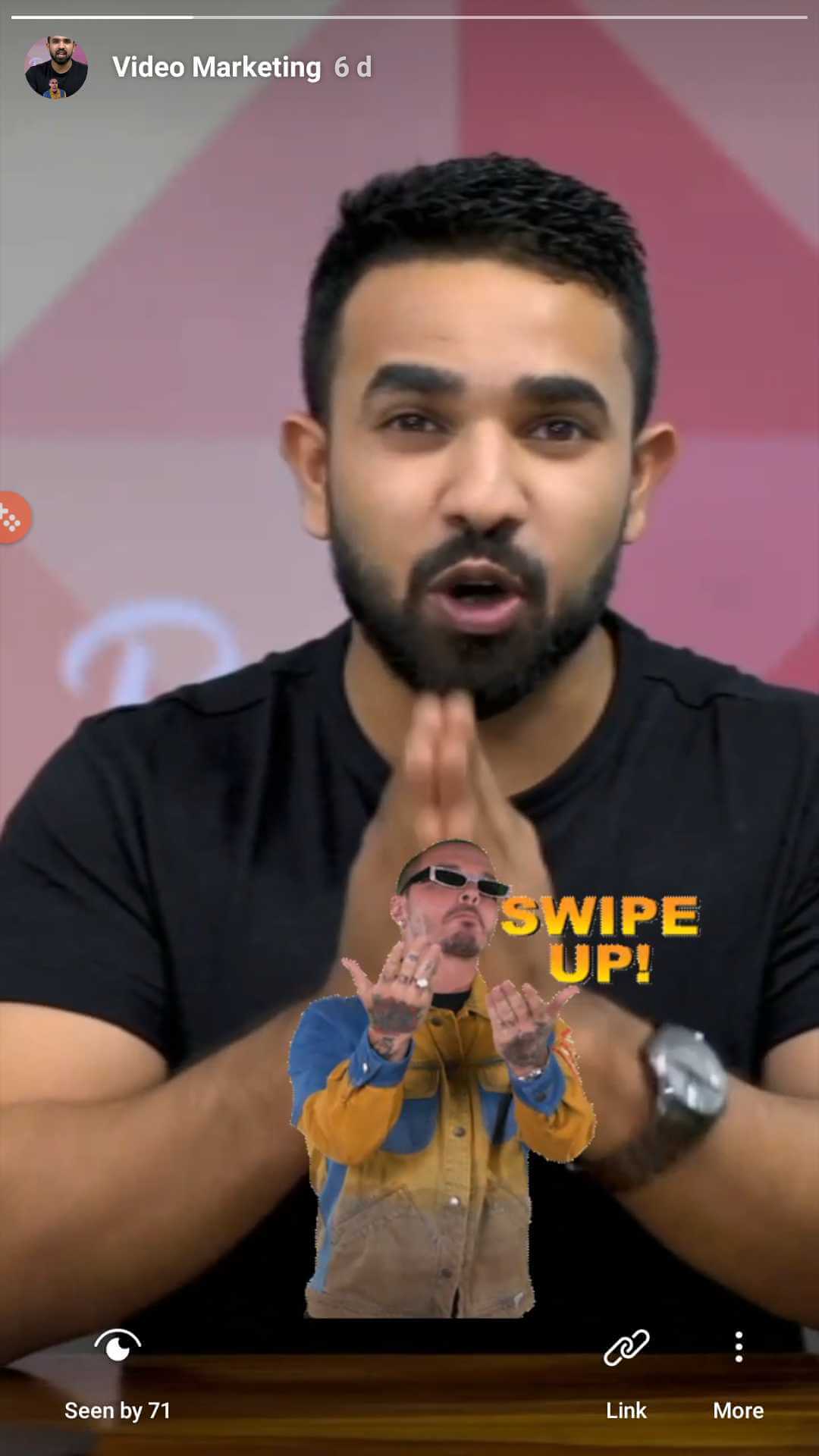
They may be features on Instagram and Facebook, but don’t underestimate the power of Stories!
There were a whopping 500 million active Instagram Story users worldwide in January 2019.
That is to say; Stories offer a huge market to tap into!
Stories last for 24 hours and let you play around with a lot of interactive filters and stickers.
They are also prime real estate because they’re always available at the top of the user’s feed.
Stories are perfect for sharing tutorials, deals or special announcements with your audience while letting your fun side shine.
They’re perfect for sharing informal videos and personal content with your
audience while letting your fun side shine.
If you’re proud of your stories, you can even save them to your profile with ‘highlights.’ This way they’re available for future viewers as well.
Tip: We recommend posting 2-3 stories a day, once every morning and evening. This way there’s always fresh content there for your followers to see.
3. Reach the right people at the right time (even when you’re asleep!)
There are certain days and times when your posts can get maximum
possible engagement. You want to get the most eyes on your content, so posting at the right time can make a huge difference.
These specifications are different for each platform, so make sure you follow the right one. We recommend checking out this guide by Sprout Social to know the best times to post on social media in 2019.
We also understand that it can be hectic and confusing to always post at the right time. Not to mention, your target audience may be in a completely different time zone.
But don’t worry – we’re giving you a simple solution — scheduling tools.
With these tools, you can schedule posts to be uploaded at strategic times and catch those zzz’s in peace. Check out these publishing tools to schedule content for your social media video marketing campaigns.
4. Increase viewership by getting your content to the right places
The first thing you probably do after creating content is to share it with your followers on social media.
But what if there are also a bunch of other people who may be interested in your brand and videos?
The only problem — They don’t know you exist or maybe don’t follow you on social media.
How do you reach and tap into this market?
Both Facebook and LinkedIn have scores of groups in all niches and industries. Join these groups and share your content with related people and businesses. This can significantly increase your video’s reach, especially to people who are genuinely interested in it!
Interact with customers, professionals and related businesses by ‘tagging’ them in your posts. This invites them to check out your content and share it with their networks.
Consider reaching out to influencers in your niche or people who you think can benefit from your video. If they find your content useful, they’re likely to share it with their own networks and voila! All eyes on your video.
5. Repurpose, reuse, recycle
The idea is that it pays off to work smarter, not harder.
Content marketing can sometimes seem like a race. That is to say; you’re constantly trying to generate and share a lot of new and original content. But what you might not be doing, is repurposing and reviving existing content to give it another chance.
Suppose you’ve written a fantastic, super long and detailed blog post. You spent hours researching, and it has everything your readers need to know about a specific topic.
You may be used to just sharing it on your blog and leaving it at that. But imagine if you could increase its reach and easily create complementary content by doing just a little extra work?
“How?” you might be asking.
By repurposing your content and posting it on social media.
Turn existing content into a video on social media to give it a new life and increase its reach. Or, use Instagram or Facebook Stories to film a video telling your followers to check out your popular blog posts.
You can even post a small snippet from your professional marketing videos to your story to promote it!
Niveditha has discussed several more actionable strategies in our complete guide.
Be sure to check them out in our article, “Social Media Video Marketing - The Ultimate Guide”
By this stage, you’ve successfully got your video out to your target audience.
Congratulations!
Your video has the potential to engage millions worldwide and deliver your message to each and every one of them.
But there’s one last step you need to take to reach the end of your video marketing campaign.

Analysing Your Video’s Performance
Tracking your video’s performance allows you to understand what improvements can be done in your next production.
There are a couple of key metrics that are commonly available no matter where your video is uploaded - Social media, Youtube, Vimeo, Vidyard etc.
Here’s how these variables can help you understand your video’s performance:
1. View count
This is the most basic metric you can use to analyse your video’s performance.
It shows you how many times your video has been viewed, giving you an idea of your video’s reach.
This makes it a great tool to have if your aim is to spread brand awareness.
However, keep in mind that every platform has a different idea as to what counts as a view.
For example, Youtube will count a view if the video is watched for more than 30 seconds while Facebook counts a view if the video is viewed for more than 3 seconds.
2. Play rate
Play rate is the ratio of the number of people who played your video to the total number of people it reached.
A high play rate implies that the video is successfully catching the attention of the target audience.
It shows you how effective your video’s Title, Description and Thumbnail are.
If your video is seeing low play rates, you may want to improve your game in these areas.
3. Shares & comments
Social shares and comments are another great way of measuring your video’s performance.
Videos with a larger number of shares and comments are proven conversation starters.
If your video is seeing high numbers in this area, it’s been successfully engaging your target audience.
If you’re seeing low numbers here, try to create more video content that can make your target audience more active.
4. Completion rate
Completion rate shows you what fraction of your audience watched your video from start to finish.
It’s a great tool because it shows you how your audience is reacting to your video’s content and delivery.
A high completion rate shows you that you’ve been successful in creating an immersive experience.
Try to boost your completion rates with more engaging storylines and stunning visuals that will keep your audience’s attention till the end of your message.
5. Click through rate
Click Through Rate shows you what portion of your video’s views have ended with the viewer answering your Call To Action (CTA).
This metric is very important if your aim was to get your viewer to complete a certain action.
If your video is seeing a low CTR, then you need to think about how you can make your video more convincing.
Maybe a change of tone?
A different angle in the script?
More relatable characters?
6. Conversion rate
Conversion rate is the ratio of the number of people who eventually completed the desired action to the number of people who responded to your CTA.
This action could be anything from actually purchasing the product to filling their details onto an online form - it depends on your video’s ultimate goal.
This is the ultimate analysis tool if the aim of your video was converting prospects into customers.
A low conversion rate signifies that your video wasn’t convincing enough.
7. Bounce rate
If you’re putting up a video on your own webpage, measuring the bounce rate of your website before and after you put up the video is a good way to measure the video’s performance.
Studies have shown that a good landing page video can decrease the website’s bounce rate by upto 34%!
It’s time.
Phew.
Yes, that’s probably a lot of information to take in now.
But implementing the tips mentioned in this 8000 word marketing bonanza is going to do wonders to your brand’s video marketing efforts.
So make sure you bookmark this page and come back over time until you’ve successfully streamlined your video marketing strategy.
If you’re looking for a fun, creative team to work with on your next video production, be sure to contact us at Studiotale.
We’re always happy to add
For more insights into all things video related, do check out our blog - Video Hub.
-2.png)




